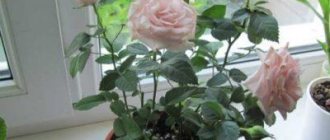In today's episode:
Who can resist the charm of delicate rose buds? Certainly not keen flower growers! Therefore, every flower lover simply must have a rose in a pot in his home collection.
Very often the purchase of a rose turns out to be spontaneous. Of course, because in the store they look very attractive. Indoor roses are often given to women who love flowers.
In any case, if you purchased a rose or received it as a gift, you will definitely find our article useful.
Caring for indoor roses at home
The bush can be classified as a very high-maintenance plant. The main rules for growing are:
- Keep the flower at an air temperature of +15 to 25 degrees.
- Spray the foliage weekly with a spray bottle: carry out water treatments early in the morning or in the evening, when it is not very hot outside. If it’s cold at home, you can do without spraying. When it's hot, perform water procedures every 3-4 days.
- For active development, it is important to have a 15-hour daylight hours.
- Caring for a rose involves regular application of organic and mineral fertilizers.
Location and lighting for the plant
In order not to ruin the plant and to promote its active development, a number of recommendations should be taken into account. Caring for homemade roses in a pot includes the following:
- Place the bush on the balcony or put it outside in the summer (ideal if you have a garden plot). At home, place the flower on a south or southeast window.
- In autumn and winter, use fluorescent lamps: this will extend the flowering period.
- During wintering, maintain the temperature from +12 to +15 degrees. If there is an insulated balcony or loggia, then place the bush there. To avoid soil freezing, place the flower pot in a box with sawdust.
- Protect the flower from the heat: do not place it near radiators or heating devices.
- To avoid drying out the soil, place the flower pot in a tray with damp pebbles: follow this recommendation, especially in winter.
- To form a beautiful bush, regularly turn it towards the light with different sides.
What does an indoor rose like?
Priming
When caring for roses, it is important to use nutritious, breathable soil with neutral acidity. It is better to buy a ready-made substrate. If you are going to prepare the soil yourself, then take turf, humus soil, sand: the proportions of the components are 4: 4: 1. If all the rules for preparing the nutrient mixture are followed, then when caring for the plant you will not often need to loosen the soil: remember that the procedure is not recommended, because it can damage the root system.
Watering
Constantly monitor the soil, do not allow it to dry out or become waterlogged. Keep in mind that watering should be plentiful only during active flowering. Caring for an indoor rose in a pot should be as follows:
- For irrigation, use settled water at room temperature.
- In the summer, when indoor roses bloom profusely, organize abundant and frequent watering: moisten the soil daily, morning and evening.
- In the fall, when the foliage falls, watering is reduced - every 7 days. Follow this recommendation if the indoor rose is located on a balcony or loggia, where coolness prevails. When the pot is located at home, where it is very warm, when watering you should focus on the soil - moisten it if the top layer is dry.
- When caring for a rose in an apartment, alternate top and bottom watering - moisten the soil or add water to the pan. In the second case, after a few hours, drain the excess liquid to avoid rotting of the root system.
- In the spring, the indoor rose wakes up and begins to actively develop, so gradually increase watering.
Caring for a ROOM ROSE
Fertilizers
To ensure that the bush enjoys abundant flowering, fertilize it regularly. When caring for roses at home, consider the following tips:
- Apply nutritional formulations from early February to November: fertilize the soil every 2 weeks, and reduce the frequency of fertilizing in the fall.
- Alternate mineral supplements with organic ones. Use ready-made preparations, bird droppings, manure: pour the fertilizer with water and leave for 10 days, then strain the composition, dilute with water (when using manure, the ratio is 1:5, if droppings are used, then the proportion is 1:10).
- After transplanting the bush, fertilize it 2 weeks later.
- Before adding the nutrient mixture, moisten the soil well: if you neglect this recommendation, burns may occur on the roots.
- In autumn, during dormancy, use additives with a small amount of nitrogen: use Bonsa, mix the drug with water (1.5 ml per 1 l).
- In spring, for better foliage development, add nitrogen-containing mixtures. To avoid bud drop, add potassium. Special preparations or organic matter - litter and manure - are suitable. To form roots, add phosphorus: apply fertilizers according to the established instructions, remember that with an excess of phosphorus, an indoor rose will develop a manganese deficiency.
- When caring for roses at home in the summer, apply foliar feeding: this provides nutrition for the foliage and protection from diseases.
Remember that it is better to use a smaller amount of the nutrient composition than to water the bush with an excessive amount of the mixture. Find out about popular fertilizers for indoor roses and the frequency of their use:
| Drug name | Application frequency |
| "Fertile-Lei-Ka" | In spring, summer - every 10-15 days, in winter - every 30 days. |
| "Agricola-Aqua" | Watering - every 7-10 days, foliar feeding - every 14 days. |
| "Rose" | In spring, summer - every 10-15 days, in autumn, winter - every month. |
| "Ambulance for Roses" | A month later. |
| "Pokon" | In spring, summer - every 14 days, in winter - every month. |
| "Gloria" | In spring - every 14 days, in winter - every 60 days, in summer - every 7 days, in autumn - every month. |
We create optimal conditions
However, the soil in the pot should not heat up, and the bush itself should not suffer from direct sunlight. An excellent place for a rose will be the western and eastern windowsill . In summer, the rose will be more comfortable on the balcony.
Watering
One of the prerequisites is to constantly maintain soil moisture. It’s worth noting right away that in many gardening manuals you can read that roses need to be provided with abundant watering. But you need to keep in mind that abundantly does not mean often. The root ball should have time to dry out. It’s time to water the rose only if your finger remains dry when pressing on the soil. If you overwater, the roots may rot and the rose will die.
The condition of the coma should be monitored especially carefully in the summer. A plant placed on the balcony sometimes needs to be watered up to twice a day, but not in the hottest time.
The rose on the balcony is watered twice a day
Roses planted in small pots need to be watered more often, as the soil in them dries out faster. In the second half of August, watering should be reduced. The plant is watered with 20-degree water. Half an hour after “watering” the bush of the pallet, excess water is removed.
Top dressing
Indoor roses bloom almost all the time, which takes a lot of their energy. Therefore, from March to October, once every eight to nine days, the bushes must be fed with complex or universal fertilizers . Fertilizers with organic matter are also suitable. In spring, roses are responsive to foliar feeding. It is enough to carry out three or four sprayings at 10-day intervals.
Indoor roses urgently need a large amount of different fertilizers.
Many gardeners advise purchasing Bona Forte for roses. The drug is excellent for both foliar application and root application.
Open ground fertilizer Bona Forte for Roses
At the end of summer, fertilizers should not contain nitrogen.
More benefits come from fertilizers applied in the evening and after watering. At low temperatures and dampness, it is better to refuse feeding and postpone it. If you have just transplanted roses, then carry out the first feeding only after a month, then every two weeks until new shoots appear.
Proper care is the key to abundant flowering
Of course, sometimes it can be difficult to find a common language with roses: they suffer from changing conditions, they may spontaneously get sick or not forgive you for too dry soil, lack of fertilizing, etc. But if you provide them with proper care, in gratitude they will delight you with abundant flowering for almost seven months!
How to replant an indoor rose
As a rule, a crop is replanted after purchasing it or to renew the soil or replace the pot. If an indoor rose was purchased, then follow these instructions:
- Do not touch the flower for 2 weeks, let it adapt.
- Place the container with the rose in a pan of water and wait half an hour.
- Carry out a water procedure: give your indoor rose a contrast shower (hot water should not be higher than 40 degrees).
- After bathing, make a greenhouse out of polyethylene: cover the bush with a bag so that it does not touch the foliage, pin the edges of the bag to the ground.
- Ventilate the greenhouse daily.
- Look at the condition of the flower. If the buds begin to fade, then the plant is ready for replanting.
- Remove the bush from the pot, immerse the roots in a container of warm water - this will help wash away the remnants of the substances with which the crop was previously treated.
- The new pot should be slightly larger than the previous one. Soak the container in water for a day: due to this, the dishes will absorb moisture and subsequently will not “take” water from the soil.
- Place drainage at the bottom of the pot, then add soil.
- Place the plant in a container, cover the roots with soil, compact it tightly.
Replanting may be necessary if the pot has become too small for the bush. The new container is thoroughly cleaned (you can use a manganese solution) and soaked in water for a day to absorb moisture. The pot with the bush is placed in a pan of water for half an hour: due to this, the earthen lump will be easier to separate from the dishes. Next, the flower is transferred to a new container and covered with earth. There is no need to water the soil. Place the pot in the shade for a few days, then move it to the light. Apply fertilizers a month after transplanting.
Transplanting indoor roses.
Care after purchase
As a rule, the age of store-bought miniature roses is three months. They haven’t really gotten stronger yet, but they are already forced to exchange the comfortable conditions of professional greenhouses for the not-so-ideal conditions of an apartment.
Even in the absence of lesions, it is important to please the plant with a warm shower. This trick will eliminate the possibility of it being damaged by spider mites. Treating the bush with Aktara will be useful .
Actara for processing purchased roses
True, this tick is not afraid of this remedy. Agrovertin is effective against it .
To combat spider mites we use Agroverin
Experienced flower growers immediately replant a faded plant . In doing so, they comply with the following rules:
- 1-3 cm drainage .
- Pruning shoots of faded transplanted roses. A couple of buds remain.
- The flowerpot should be larger than the old one by about six centimeters in height and a couple of centimeters in diameter. But, of course, if the purchased rose sits in a miniature glass, you should take a larger pot. Usually the flowerpot is selected in such a way that its height is approximately the same as the height of the bush itself. For the first year, it is better to choose a pot with a 10-centimeter height and a 10-centimeter diameter.
- The composition of the mixture prepared on your own: turf soil + leaf soil + peat + sand. The ratio of ingredients is 4:2:2:1. Fine expanded clay (just a little bit) will be useful - it will remove excess moisture from the mixture.
- Preserving the integrity of the coma during transplantation and carefully transferring it into a new pot , followed by adding new soil around the edges.
- 2-fold treatment of the plant with a growth stimulator . For this purpose it is better to use Zircon.
The first two weeks will be the hardest for the rose; it may even shed its leaves. But after adaptation, the bush will begin to grow again.
In the future, plants will be replanted with bushes that become cramped in pots. The best time for transplantation is February. This month the bushes emerge from winter hibernation.
Article on the topic: Volzhanka - planting and care, types and varieties, photos and propagation
Bloom
If proper care is provided for your home rose, it blooms from April-May to October. The constant formation of new buds occurs due to the timely removal of dry flowers. Remember that an indoor rose may not please with its splendor due to the heat. Prevent the pot from overheating in the sun: wrap the container in white paper, do not place the bush in the sun.
It often happens that a crop does not bloom. This occurs due to improper care at home:
- lack of the required amount of light - it is necessary to move the pot to a south, south-west window, an insulated balcony or loggia, and install fluorescent lamps;
- unsuitable soil - you need not too loose, water-permeable, breathable soil with neutral acidity - pH 6.5-7.5;
- it is too hot or cold in the room - you need to move the plant to a place where humid air prevails, the air temperature is from +15 to 25 degrees, there are no drafts;
- insufficient nutrition - organic and mineral fertilizers should be applied in a timely manner;
- too much pruning - undesirable in the presence of an adult, weakly developing bush;
- improper formation of the bush - you need to prune the bush correctly in the fall;
- the presence of diseases, pests - carefully monitor the condition of the crop, if necessary, urgently treat it with special preparations.
In autumn, the plant is moved home from the street. It is important that the air temperature at home is +15-18 degrees. Do not place the crop near heating appliances. After the end of the budding period, pruning should be done - remove shoots and stems so that 5 buds remain on them. Caring for a rose at home in the fall involves gradually reducing watering and stopping fertilizing.
- Inflammation of the sciatic nerve - symptoms and treatment with medications and folk remedies
- How to draw arrows on the eyes correctly
- AMH hormone - what it is and what it is responsible for in women
How to care in winter
When dormant, you need to reduce watering
The winter season is a dormant period for roses, requiring changes in its maintenance regime. The plant is transferred to a cool place where the temperature is between 6-8 °C. Since apartments are heated at this time of year, the optimal place is a glazed balcony or loggia.
The culture should be in warm soil. To do this, the pot is placed in a box with sawdust. It is necessary to regularly monitor the temperature level in the room where the plant is located. If the reading drops below 6 °C, the rose should be moved to a warmer place. Watering is carried out rarely, only when the soil dries out.
Trimming
It is best to prune the flower in the spring with 10 hours of daylight, when the crop is actively developing, or in the fall, before wintering. When pruning, branches that have lengthened over the winter, weak shoots, and dried flowers are removed. Use a sharp knife to avoid leaving ragged areas that could cause the plant to die. Trim branches to 5mm above outward-facing buds. Be sure to make oblique cuts. There are the following types of pruning:
- Light - 2/3 of the stem length is removed. This treatment method is recommended for vigorous bushes. Do not prune your indoor rose this way for several years in a row, otherwise it will become very elongated and will not bloom.
- Moderate – approximately half the length of the stem is removed. Use this method if you have an adult indoor rose at home.
- Strong - used if the plant is young or needs to be renewed. The shoots are cut to the level of the third and fourth buds from the base.
PRUNING A ROSE. When and how to prune an indoor rose correctly!
Feature 1: Substrate and Pots
To grow roses at home, you need to know that the garden variety is not suitable for this. There is a special variety for growing in the house - indoor rose, which differs from garden roses in the size and type of flowers.
If you purchased an indoor rose at a flower shop, you should not replant it immediately; you need to know some rules:
- The rose is a very vulnerable flower, so it needs to adapt gently to its new habitat;
- Rose transplantation can begin after 2 - 3 weeks, if there are no signs of disease or wilting;
- when planting a rose, it is necessary to provide drainage so that the roots do not rot from a possible excess of moisture;
- Expanded clay is good for plant drainage.
Immediately after planting, the rose should be placed in a dark place or on a north window, and the next day it can be moved to its permanent habitat.
Soil for planting
Rose is very picky about the soil in which it grows. If you plant it in the wrong soil, it may not bloom and stop developing.
- It is best to plant a rose in special soil, which is sold in flower shops;
- For good rose growth, mix one part of sand and four parts of humus and turf soil;
- Before planting a flower, you should water the soil well and let the water soak in for about 20 minutes.
Choosing a pot
To choose the right pot for an indoor rose you need to know:
- the pot for replanting should not be much larger than the previous one;
- the new flowerpot should be two fingers taller and wider, since the rose develops its root system to fit its size and may forget about flowering;
- if the pot is new and nothing was grown in it, before planting it must be soaked for two hours in warm water;
- If a plant was previously grown in a pot, it must be washed well with a brush without soap.
Helpful Tips:
- The thickness of the drainage layer when planting a rose should be no less than one centimeter.
- If the rose pot has no holes, add 3 to 5 centimeters of drainage.
- The above-ground part of the rose should be in a 1:1 ratio with the height of the pot.
Reproduction
When caring for a rose at home, you may need to propagate it. Many gardeners choose the cutting method. The branches are cut using a sharp knife, which has been previously treated with a solution of manganese or alcohol. Make an oblique cut, under the bud: with this approach, the cutting will take root well. The upper cut is made 5 mm above the kidney. Remove the leaves from the bottom of the cutting. Next, you can perform soil propagation:
- For 10-12 hours, place the cuttings in a solution with heteroauxin (take 4 tablets per 1 cup of water).
- Plant the cuttings in sand (you can add peat).
- Create a greenhouse from a plastic bag or cut-off bottle.
- Do not water the cuttings.
- Make sure that the temperature inside the greenhouse is at least +18 degrees.
- Do not place the container with cuttings in direct sunlight.
- After a month, the branches will take root, after which remove the greenhouse to adapt them to the air at home.
There is another popular method of propagation, when the cuttings are placed in water for a long time. The growing instructions are as follows:
- Cutting cuttings is the same as for soil propagation. The only difference is that their length should be 15 cm.
- Take a jar or glass of water and cover the container with a lid with holes. You need to insert cuttings into the holes. They should be immersed in 2 cm of water.
- If the house is hot, spray the branches daily.
- Transplantation into the ground is carried out after roots grow 1.5 cm long. Remember that cuttings develop better in the presence of a lot of light.
Conditions of keeping and growing
If the care is correct, the rose will delight you with abundant flowering from the beginning of spring to mid-autumn. The decorative effect is maintained through regular pruning. The average lifespan of indoor mini-roses without loss of decorativeness is up to five years.
Illumination and temperature conditions
Lots of light is the key to active growth and flowering. The light should be diffused, if the windows are south facing, shading is needed at noon. Optimal directions – east or west
If the pot is on a windowsill, it is important to protect it from heating the soil. Place away from batteries and direct sunlight
Important! Regular ventilation is important for roses. Temperatures in summer are tolerable up to 25 °C
If the thermometer rises higher, additional humidification of the air around the pot is required. In winter, the plant should be wintered. In sleep mode, the temperature should not rise above 10 °C
Temperatures in summer are tolerable up to 25 °C. If the thermometer rises higher, additional humidification of the air around the pot is required. In winter, the plant should be wintered. In sleep mode, the temperature should not rise above 10 °C.
Watering rules and humidity
It is necessary to water abundantly during the active period of growth and flowering. Watering has been picking up pace since the end of February.
And already in the summer months it is important to ensure that the earthen lump never dries out. During hibernation, watering is reduced to a minimum.
Rose loves humidity and spraying. Daily procedures will be beneficial. Spraying should be done in the morning so that the droplets have time to dry and not burn the leaves at noon. Once a week you can take a warm shower.
Important! During spraying and showering, you need to make sure that water does not get on the buds and flowers. On hot days, the pot is placed on pallets with wet pebbles or expanded clay.
You can place containers with aqua soil near pots of roses. The plant will not tolerate overheating
On hot days, the pot is placed on trays with wet pebbles or expanded clay. You can place containers with aqua soil near pots of roses. The plant will not tolerate overheating.
Fertilizing and soil quality
From the beginning of spring, nitrogen-containing fertilizers are applied twice a month to actively increase green mass.
Feeding is also needed during flowering. The release of buds takes a lot of energy reserves. They need to be fed once every two weeks with complex fertilizers containing potassium and phosphorus. They are responsible for the formation of buds and the rich color of the inflorescences.
Flower container size
The pot for the bush should be medium in size. It is necessary to have holes and a drainage layer of at least 2 cm. When replanting again, the pot needs to be larger in diameter by just a couple of centimeters.
Pruning and replanting
Pruning must be done at the very end of wintering. The procedure is needed for the following purposes:
- awakening of the kidneys;
- bush formation;
- growth of young shoots;
- removal of old, dry and damaged branches.
Important! Only young shoots that have grown this year produce buds. Pruning doesn't have to be gentle
Good shoots are cut to 3-4 buds, their length should not exceed 10 cm. Bad and damaged branches are completely removed
Pruning should not be gentle. Good shoots are cut to 3-4 buds, their length should not exceed 10 cm. Bad and damaged branches are completely removed.
Preventive pruning is carried out throughout the active growth period. Wilted flowers must be cut off so that the flower does not waste energy on forming a seed. Leaves that begin to turn yellow and dry out should be cut off immediately.
Removing faded flowers
The plant needs to be replanted once every two years. The soil needs to be light and nutritious. Peat and sand are added to garden soil. It is permissible to add humus.
What to do if a rose in a pot dries out
This problem is often encountered both in summer and winter. When caring at home, indoor roses may dry out due to:
- the presence of a damaged root system: the plant stops absorbing nutrients and moisture;
- insufficient watering;
- low humidity levels;
- too dry air, heat: often the leaves dry out due to the placement of the flower near the radiators.
After discovering dry foliage, immediately begin rescuing the plant. Do the following:
- Check the ground. If it is dry, then water the flower well.
- Make sure the pot is kept away from heating devices. If necessary, move the indoor rose.
- Place the pot in a tray with damp expanded clay.
- Spray the foliage: repeat the procedure every 4 days.
- If the bush is small, then cover it with a transparent bag or bottle to maintain a high level of air and soil humidity. Keep the plant like this until it is completely restored.
The most popular varieties for growing indoors
Indoor or indoor lily in a pot - how to care
There are many different varieties of roses designed for indoor growing. The following types are considered the most popular:
Bengal
Very unpretentious look. The height of the bushes reaches 50 cm. The foliage and flowers are quite small. Rich, bright inflorescences delight owners throughout the year, with the exception of short rest breaks. Most often, flower growers show interest in the Pink Grotendorst variety, which blooms in both spring and summer. Its flowers are able to maintain their freshness for a long time.
Bengal roses
For your information! A special feature of the variety is that the plants shed their leaves at the end of August, while new ones grow very quickly.
Miniature
The height of the bushes is up to 30 cm. Shrub roses are unpretentious and reproduce well. The most famous variety is Cardana. The variety of flower colors is quite large, and it is constantly updated with new shades. The attention of flower growers is also often attracted by the Green Ice variety. Its leaves are dark green, and its delicate inflorescences are pale green.
Miniature
Teahouses
This species is similar to Bengal roses. The plant has double inflorescences that emit a unique aroma. The best varieties are considered to be Marshall Niel, which has yellow buds, and Nifetos, with pale pink petals.
Teahouses
Polyanthaceae
This group pleases with a multi-flowered variety of roses. Double and semi-double inflorescences have very beautiful buds. The bushes themselves are quite branched, the foliage is large. One of the most popular varieties is Triumph, which has a wonderful aroma emanating from red flowers.
Polyanthaceae
Diseases and pests
Flower growers often complain about various diseases of their plants. Often illnesses appear due to improper care at home. An indoor rose may suffer from the following diseases and pests:
| Disease, pests | External signs | Causes | Fighting methods |
| Spider mite | The foliage turns yellow, falls off, cobwebs appear, and the plant gradually dries out. | Insufficient air humidity, drying out soil. | It is almost impossible to get rid of it at home. Methods are used to prevent the appearance of the pest: in spring and autumn, the plant is treated with special preparations such as “Fitoverma” (2 ml per 1 liter of water), “Aktellika” (1 ml per 1 liter of water). When processing foliage, alternate the compositions to avoid addiction. Prevention - regular spraying, bathing in the shower. |
| Powdery mildew | It is a fungal disease, the sign of which is a white coating on the foliage. | Occurs due to increased soil and air humidity. | If no measures are taken, the plant will die. When treating at home, use the drug “Topaz” (2 ml per 5 liters of water) every 14 days. Prevention of the disease - moderate watering, removal of dry leaves under the bush, loosening the soil. |
| Blackleg | The stem begins to turn black. | Occurs due to excessive watering and weak immunity of the flower. | To cure an indoor rose at home, water it with a strong solution of manganese potassium, a mixture of water and Fitosporin (component ratio 2:1). This method is suitable if the disease has not developed too much. If it is neglected, it will not be possible to save an indoor rose at home. |
| Chlorosis or iron deficiency | The leaves turn yellow, fall off, and green stripes appear along the veins. | Unsuitable soil: excessive acidity or alkalinity, lack of iron in the composition. | For treatment, foliar feeding is carried out using chelated iron or other nutritional sprays with the required content of the substance. Check the soil pH: the desired value is 6.5-7.5. If necessary, eliminate excess acidity and alkalinity: add lime or, to increase acidity, rotted manure, “Superphosphate,” or phosphorus flour. |
| Thrips or rose aphids | Leaves and buds are deformed. | The presence of dry foliage under a bush, contaminated soil or a neighbor's rose garden. | Treatment at home is carried out with insecticides: “Aktara”, “Fitoverm”. |
| Black spot | Dark spots with a diameter of 6 to 16 mm on the outside of leaves, young shoots and stems. Over time, the foliage turns yellow and falls off. Culture lags behind in development. | Increased air and soil humidity, lack of light, lack of treatment of branches with coal after pruning, excess nitrogen fertilizers. | When caring at home, spray with fungicides: “Ridomil”, “Fundazol”, “Profit”, “Topaz”, Bordeaux mixture. |
| Gray mold | Brown and black spots on foliage. The foliage turns yellow, falls off, and without treatment, the crop dies after 2 seasons. | Purchase of an infected plant, lack of timely fertilizing, pruning, loosening of the soil, presence of foliage under the bush. | The method of control when caring at home, as in the previous case. |
| Rust | Reddish-brown spots on the leaves. | Increased soil and air humidity, excessive watering. | It is important that there is good air circulation at home. Spray with Topaz, Abiga-Peak, Bordeaux mixture, and copper sulfate solution. Prevention - regular loosening of the soil, moderate watering, regular ventilation of the room. |
We treat indoor roses from diseases! The most common diseases of roses and their treatment!
Common types, photos and names
There are quite a few varieties of roses for interiors. Let's get acquainted with the most popular of them.
Bengal rose
This culture is believed to be native to the eastern part of India. This plant does not shed its leaves, blooms two to three times a year and does not require a dormant period.
Bengal beauty is a spreading, dense shrub with long stems. The inflorescences are medium-sized, up to 7 centimeters in diameter, the petals on the buds are golden, white, pink, orange, yellow or red.
miniature rose
These dwarf flowers appeared in our country in 1810 and were brought from China. Miniature roses are small plants with a compact bush, growing from 10 to 30 centimeters in height. In appearance, they resemble their relatives, which we are used to growing in the garden.
The leaves of the plant are standard dark green, small, with a dull surface. The inflorescences are fragrant, bright and multi-colored. The varieties do not require pruning and bloom throughout the summer. Some varieties of these plants can be seen in the picture.
Baby Carnival
This plant is a miniature variety. The flowering shrub reaches a height of up to 45 cm and a diameter of about 40 cm. The propagating stems are branched, well-leafed with a minimum number of thorns.
The leaves are dark green with a glossy, shiny surface. The shoots are reddish, the buds in the initial stage of development are golden, later red; the petals are swollen.
Baby Carnival inflorescences have a diameter of 3 to 5 centimeters. This crop blooms throughout the summer.
Pixie
Miniature rose Pixie is a small and compact plant up to 40 centimeters high. The inflorescences are small, up to 3 cm in diameter, of various colors, with simple or pompom-like petals.
Propagation by cuttings. Roses bloom profusely throughout the summer.
Watering and humidity
House roses love moist air, and since it is usually excessively dry indoors, the plant needs to be sprayed periodically. During the active growing season and summer, spraying is carried out with settled water daily. It is necessary to ensure that drops of water do not stagnate in the axils of the leaves. In winter and cloudy weather there is no need to spray the flower. A comfortable microclimate can be provided by a tray or any container with water near the plant.
The frequency of watering depends on the growing season. In winter, when the plant rests and does not bloom, watering is carried out rarely, only to ensure that the soil does not dry out. In the spring, when the rose wakes up in its pot, it needs to be watered more often. In summer, during flowering, watering is carried out daily or as needed, making sure that the soil is always slightly moist.
Long and abundant flowering takes a lot of energy from the rose, which needs to be replenished with fertilizing. Since liquid fertilizers are preferred for it, during watering the plant can be fed with a solution of manure, mullein, as well as ready-made complex mixtures. When using mineral and organic fertilizers simultaneously, we feed the flower alternately once every 2 weeks.
Transfer
A young plant that is less than 4 years old is transplanted into a new pot every year. Buy a clay pot with a drainage hole. The plastic variety is also suitable, always with a tray. The new pot should be 4–5 cm wider and 6–8 cm higher than the old container.
A flowerpot purchased in a store is washed with warm water. Sometimes a little antibacterial soap is added, but after the procedure the container is rinsed thoroughly. Clay pots are soaked in warm water for several hours.
Old flowerpots in which another flower lived are cleaned of soil residues using a soap solution. Then rinse and pour over boiling water. Hot water will destroy infection and fungus that may remain on the walls of the pot.
The flowerpot is filled with a drainage layer consisting of grated foam, broken bricks or clay shards. Small pebbles or porcelain tiles are suitable. The height of the drainage layer is approximately 4 cm.
A nutrient mixture is poured into the pot, which is prepared from 3 components:
- turf soil;
- coarse river sand;
- rotted manure.
The soil and sand are calcined or steamed. Insects and pathogens can live in soil brought from a vegetable garden or garden. Sometimes peat is added to the substrate for decorative roses.
About a liter of water is poured into an old pot with a decorative bush to soften the soil. After 20 minutes, put on thick rubber gloves and grasp the flower at the base. The flowerpot is turned over and carefully removed from the earthen clod. Sometimes the pot needs to be rotated several times around the rose so that the substrate is separated from the clay walls.
The soil from the root system is cleaned if insects or fungus have infested it. The substrate is carefully removed by hand, and then the base of the decorative bush is washed with warm water. In other cases, the flower is transferred to a new pot along with the old soil.
3–5 cm of soil is poured into the pot. The roots of a decorative bush are placed on a compacted earthen bed. Straighten and cover with a layer of substrate. Pour 50–60 ml of water into the soil and wait for it to settle. Then add a portion of soil so that it covers the roots of the rose.
The pot with the decorative bush is placed in a warm room, but hidden from direct sunlight. Do not water for 5–6 days. During this period, the transplanted plant takes root and adapts to new conditions. The rose is returned to the windowsill after a week, and after 14–21 days mineral fertilizing is applied.
The ornamental bush is replanted in early spring before the first buds appear. Sometimes the procedure is carried out in late autumn, after the last petals have fallen. But then there is no need to fertilize, because the rose “hibernates.” Fertilizers can trigger flowering, which will weaken the houseplant.











